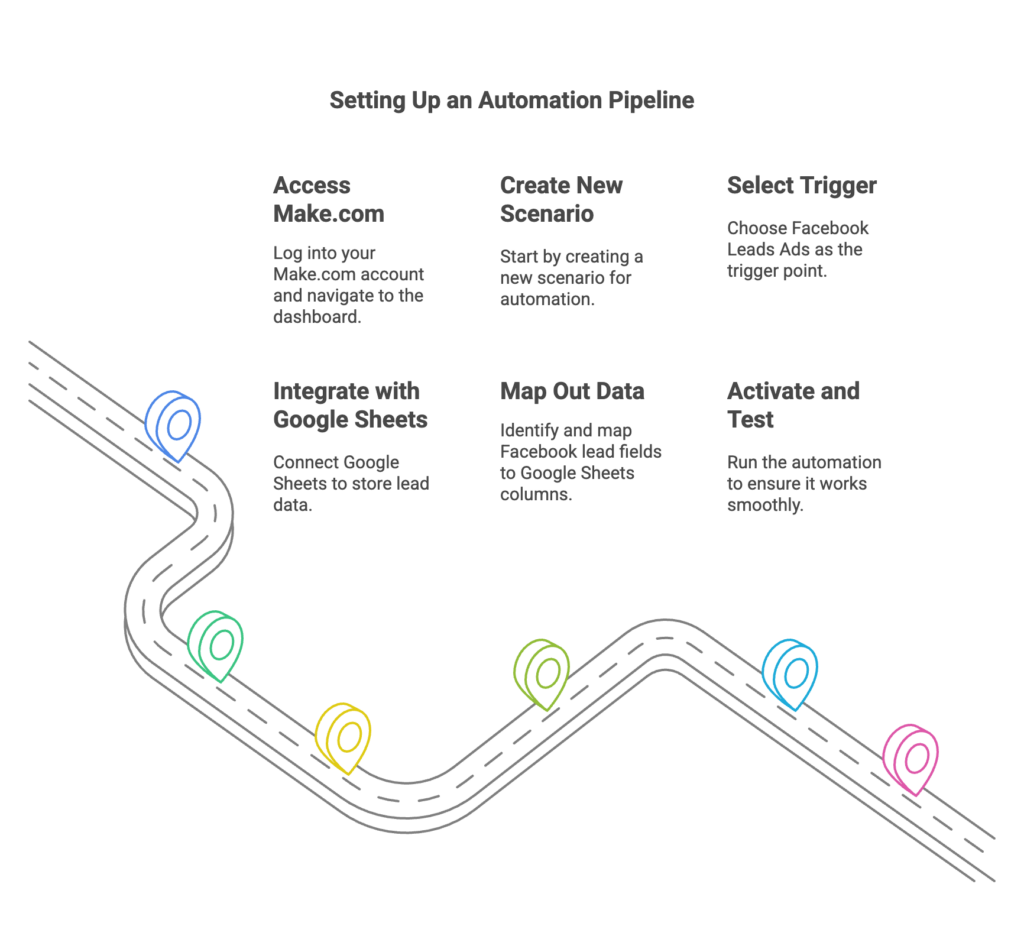Mastering Automation: A Beginner’s Guide to Streamlining Tasks with Make.com

If I told you that you could automate your entire payroll department, saving countless hours and probably opening the way for more growth, would you believe me? What if I told you it can be done in just a few weeks? You can. With automation tools like Make.com you can “string” together different applications (including AI models) to perform complex workflows that your employees are handling right now.
Thanks to these automation tools it’s really simple. In this article I’m going to go over the basics of one very popular automation tool, Make.com, and how to get started automating workflows for your business. Whether you’re a business owner, a freelancer, or just getting started, the potential benefits of automation through platforms like Make.com are limitless.
We’re going to be going into lots of uses cases to give you plenty of ideas on where to start.
Getting Started with Make.com
Introduction to Make.com
Diving into automation doesn’t have to be overwhelming, especially with platforms like Make.com on our side. Known for its user-friendly interface, Make.com simplifies automation tasks, making them accessible even to those with minimal technical know-how. Upon signing up, users are greeted with an intuitive dashboard brimming with features designed to streamline processes and enhance productivity.
Getting started is a breeze. The sign-up process is straightforward: provide your basic information, and you’re guided through selecting preferences to tailor the platform to your specific needs. Whether you’re looking to manage leads or automate internal tasks, Make.com does a good job of staying flexible enough to accommodate your needs.
Creating Your First Automation Pipeline
Let’s set up your first automation pipeline. Think of it as crafting a pathway that connects various apps to perform tasks without manual input. Imagine this scenario: you want to automatically capture new Facebook leads and log them into a Google Sheet, ensuring you never miss a potential customer.
Follow these simple steps to set it all up:
- Access Make.com: Log into your account and navigate to the dashboard.
- Create a new scenario: Start by creating a new scenario, which will serve as your automation blueprint.
- Select your trigger: Choose Facebook Leads Ads as the trigger point. This step tells the platform when to start the automation.
- Integrate with Google Sheets: Connect Google Sheets to store the data. Make.com allows straightforward app integration, guiding you through the process without needing any coding skills.
- Map out the data: Identify which data fields from Facebook leads you need and map them to corresponding columns in Google Sheets.
- Activate and test: Run the automation to ensure everything flows smoothly. Watch as new leads automatically populate your Google Sheet.

With just a few clicks, you’ve set up an automation pipeline that saves countless hours of manual entry. You can further explore and customize scenarios as you get more comfortable with the platform, unlocking endless automation possibilities across various applications.
Advanced Task Automations
Lead Management Automation
Streamlining lead management is crucial for businesses looking to optimize their sales processes. By automating lead collection from web forms, companies can ensure no potential customer slips through the cracks. For example, integrating tools like Clearbit with your CRM can automatically enhance profiles with domain information, offering valuable insights at a glance. Imagine capturing lead details and seeing them updated in real-time with enriched data, all while you focus on more strategic tasks.
E-commerce and Property Description Automation
Let’s take a look at a set of example industries: e-commerce and real estate. If you’re a company in one of these areas, the ability to generate and enhance descriptions quickly is invaluable. Utilizing platforms like Make.com, you can automate description creation directly from Google Sheets data using OpenAI’s ChatGPT. By also tapping into the OpenAI API, these descriptions can be enhanced with geographical proximity information, providing potential buyers or renters with rich, enticing content that addresses location-specific benefits—effortlessly attracting more interest in properties or products.
Ticketing and Barcode Automation
For event organizers, automating the ticketing process can be a game changer. With Google Sheets and Docs, you can seamlessly create tickets embedded with unique barcodes for each attendee. This not only speeds up the ticket generation process but also reduces errors associated with manual entry. By setting up a streamlined ticketing process, event managers can focus more on curating exceptional experiences and less on the logistics of ticket distribution.

These advanced task automations demonstrate how Make.com can turn complex processes into manageable workflows, enhancing efficiency and clarity across various sectors. Whether it’s handling leads, creating compelling descriptions, or managing event tickets, automation offers clear advantages in precision and productivity. As you incorporate these strategies into your operations, you’ll likely find new opportunities for growth and innovation.
Internal Task Automation
Automating Internal Admin Tasks
Streamlining internal administrative tasks can significantly boost productivity and reduce the monotony of day-to-day work. One pivotal example is automating the creation of Google Calendar events directly from Trello. By linking these two platforms, project deadlines, meetings, and task reminders can be scheduled automatically, keeping everyone in sync without the need for manual updates.

This type of automation has several advantages, such as:
- Time-saving: Automating recurring tasks frees up valuable time for team members to focus on more strategic initiatives.
- Error Reduction: Automatically syncing data between platforms minimizes the potential for human error, ensuring accuracy and reliability.
- Enhanced Collaboration: Centralized scheduling improves team coordination by making sure that everyone is informed and working towards the same deadlines.
Example Use Cases of Internal Automation
To bring the power of internal task automation into perspective, consider these use cases:
- Discord and Google Sheets Integration: Imagine a scenario where messages from specific Discord channels are automatically logged in a Google Sheet. This saves time spent on manual data entry and ensures that information is always up-to-date.
- Managing Requests and Permissions: Automating the handling of internal requests, such as vacation approvals or access permissions, can streamline workflows and accelerate decision-making processes. Automation software can track, notify, and even approve requests based on predefined rules, thereby enhancing efficiency and accountability.
The essence of internal task automation lies in its ability to reinforce productivity while maintaining a low error threshold. These solutions are all about smart work, reducing the labor of managing routine activities, and liberating human resources to tackle more creative and challenging projects. By implementing such automations, businesses can realize significant improvements in both workflow efficacy and employee satisfaction, reflecting the transformative potential of leveraging technology in everyday operations.
Harnessing AI for Enhanced Automation
Using AI for Email Automations
In today’s digital landscape, handling an ever-increasing flow of emails can become overwhelming. Imagine a world where your emails are automatically categorized and replied to based on their content – that’s where AI steps in. Setting up scenarios with tools like the OpenAI API allows you to create smart systems that can assess the category of emails and draft unique responses accordingly. This way, you can ensure no important communication slips through the cracks and that each interaction is personalized and efficient.
Envision your system sending a personalized, warm response to a new client inquiry or prioritizing urgent emails while providing thoughtful templates for routine requests. Not only does this streamline your workflow, but it also enhances the professional responsiveness of your communication channels.
AI-Powered Decision-Making in Automations
Incorporating AI into your business operations can do wonders beyond email handling. Consider AI as the brain behind intelligent decision-making processes. By integrating AI, businesses can improve their operational efficiency and agility. For example, AI can help analyze client data to predict buying behavior, allowing your team to make informed decisions swiftly.
Furthermore, AI-driven insights can guide inventory management by suggesting optimal stock quantities based on market trends and consumer demand. The potential applications are vast, spanning customer service optimization to financial modeling. By leveraging these capabilities, businesses can stay ahead of the curve, gaining insights that might remain hidden in traditional workflows.
Overall, the blend of AI and automation opens up a realm of possibilities that can transform how businesses operate. Whether it’s smart email responses or strategic decision-making, the integration of AI enhances both efficiency and the quality of outcomes, paving the way for innovative practices.
Conclusion
By embracing automation, you’re not just optimizing your workflows; you’re positioning yourself at the forefront of a technological revolution that promises to redefine efficiency and innovation. As you continue to develop and implement automation strategies, may you find even greater creative solutions that enhance both your professional and personal life.
Here’s to a future powered by smart, effective automation!